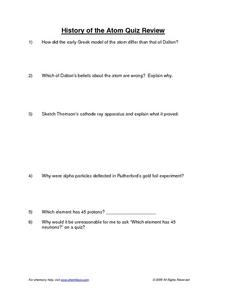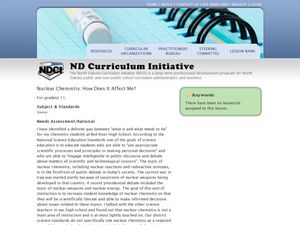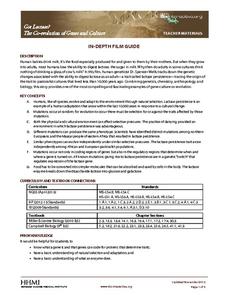Curated OER
History of Chemistry: The Alchemists
Students research alchemy and the history of chemistry. In this chemistry history lesson, students examine laboratory apparatus and compare it to those used by the Alchemists. Students complete a research paper on an important...
Curated OER
History of the Atom
This is a tremendous overview of the tiny atom. Journey through the history of human understanding of this basic building block of matter. Examine each of the sub-atomic particles in detail: neutrons, protons, electrons, quarks. Peruse...
American Chemical Society
Man and Materials Through History
From the start of the Industrial Revolution, it only took 147 years for someone to invent plastic. This may seem like a long time, but in the history of inventing or discovering new materials, this is incredibly fast. An informative and...
Curated OER
The Nobel Prize in Chemistry 2003 - Information for the Public
An information-packed eight-page article detailing the history of understanding active transport across cell membranes makes up the bulk of this handout. Two pages of reading comprehension and critical-thinking questions follow. The...
Curated OER
QR Coded Audio Periodic Table of the Elements
Take the periodic table into the digital age with QR codes that take the scanner to an audio recording about each element from the Royal Society of Chemistry. Enlarge the image, then use a smartphone or tablet to scan the code for an...
Curated OER
Elements of Chemistry: Atoms: The Building Blocks of Matter
Students explore scientific theories and the works of scientists. In this chemistry lesson students develop a timeline that shows how scientists work was built on the ones before them.
Curated OER
It's a Gas! Or is it?
Examine the effects of temperature and pressure on solubility and the states of matter of ocean water. Learners make inferences about the unique chemistry of ocean water at different depths. They engage in an activity related to...
Curated OER
Atomic Structure
A flashy PowerPoint includes clear summaries of atomic structure and electronic configuration. Dot and cross diagrams will help viewers learn how to draw an atom. As a result, learners should be more clear how electronic configuration...
Royal Society of Chemistry
The 400m Event—Chemistry and Sport
How do Olympic runners succeed in physically demanding events like the 400-meter dash? Physiology scholars explore the relationship between acids, bases, and the muscular system through a scenario-driven activity. The lesson focuses on...
Curated OER
History of the Atom Quiz Review
For this history of the atom worksheet, high schoolers answer questions about Thomson's cathode ray apparatus, Rutherford's gold foil experiment and Dalton's beliefs about the atom. Students identify the number of protons, neutrons and...
Curated OER
Nuclear Chemistry
In this nuclear chemistry activity, students answer 9 questions. They balance nuclear equations, they write balanced equations, they calculate decay and they find binding energy of atoms.
Urbana School District
Magnetism
The compass was first used in 206 B.C., but we didn't discover magnetic poles until 1263 A.D. Presentation begins with the history of magnetism before continuing on to magnetic fields, magnetic forces, electromagnets, currents,...
Curated OER
Discovering Elements
A periodic table of elements displays the elements in groups ordered by when they were discovered. Click-by-click, new elements are added, resulting in an almost up-to-date chart. In order to reinforce the idea that symbols are used in...
Curated OER
Periodic Webquest
Sixth graders explore the periodic table of elements. Using given websites, 6th graders explore the history of the periodic table and its design. Students role play, writing a journal entry, as if they were the author of the periodic table.
NOAA
History's Thermometers
How is sea coral like a thermometer? Part three of a six-part series from NOAA describes how oceanographers can use coral growth to estimate water temperature over time. Life science pupils manipulate data to determine the age of corals...
Curated OER
Nuclear Chemistry: How Does It Affect Me?
Eleventh graders study the different areas of nuclear chemistry. In this energy and critical thinking lesson students study radiation, nuclear energy and weapons then divide into groups and create a poster.
Curated OER
Ancient Atomic Theories
Studdnts research ancient texts and compare ancient Greek atomic theories, as used in the production of silver, to modern theories.
Curated OER
Early History of the Atom Homework
In this early history of the atom worksheet, students answer 4 questions about Thomson's Plum Pudding model of the atom and Rutherford's experiment that led to the understanding of some of the structures of the atom.
Curated OER
Striking it Rich with Chemistry
Students identify the composition of different pennies. In this chemistry lesson, students use a post 1982 penny to observe chemical change. They explain how to turn a penny from copper to gold.
Curated OER
Atomic Structure
The first nine slides visit the history of our understanding of atoms. The next several outline the structure of atoms. Subatomic particles, electron configuration, and diagramming methods are introduced. This is a neatly organized...
Curated OER
Chemistry - Atoms and Elements
Middle schoolers perform varied activities as part of a layered curriculum unit: They write and perform a skit that outlines the evolution of the model of the atom. The script is submitted to the teacher for review before performance.
Curated OER
History of the Battery
Young scholars study the development of batteries. In this electrochemistry lesson plan, students compare the different types of batteries. They explore its applications especially in the medical field.
Curated OER
Chemistry and Commercial Fertilizers
Students listen as the teacher lectures about the history of commercial fertilizers. The activity includes extensive information for the teacher. Following the lecture, students complete a worksheet titled "Nitrogen Cycle Problems." The...
Howard Hughes Medical Institute
Got Lactase? The Co-Evolution of Genes and Culture
Does the human body evolve as quickly as human culture? With a stellar 15-minute video, explore the trait of lactose intolerance. Only about 1/3 of human adults seem to still have the enzyme lactase and therefore, the ability to digest...
Other popular searches
- History of Chemistry
- Brief History of Chemistry
- The History of Chemistry
- History of Chemistry Ppt
- History of Chemistry Pot

























